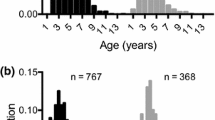Abstract
This study explored the risk of predation by trout (non-host predator) on adult hairworms Gordionus chinensis. Ten percent of trout (18 out of 187 trout) ingested adult hairworms in a Japanese headwater stream of the Totsu River. All hairworms were ingested by trout that had also ingested their insect definitive hosts (camel crickets: Tachycines elegantissima and T. asynamorus). Trout had never foraged hairworms directly in the two field experiments. These results suggest that hairworms were ingested by trout via predation on their hosts. Large trout ingested hairworms more frequently than smaller trout did. The larger trout were more abundant in the main stem compared with the upper tributary, which might suggest spatial heterogeneity of predation risk for adult hairworms within a river system.




Similar content being viewed by others
References
Begon M, Harper JL, Townsend CR (1990) Ecology: Individuals, Populations and Communities, 2nd edn. Blackwell, New York
Cochran PA, Kinziger AP, Poly WJ (1999) Predation on horsehair worms (Phylum Nematomorpha). J Freshw Ecol 14:211–218
Dobson AP, Lafferty KD, Kuris AM (2006) Parasites and food webs. In: Pascual M, Dunne JA (eds) Ecological networks: linking structure to dynamics in food webs. Oxford University Press, New York, pp 119–135
Giles N (1980) A stomach sampler for use on live fish. J Fish Biol 16:441–444
Hanelt B, Thomas F, Schmidt-Rhaesa A (2005) Biology of the Phylum Nematomorpha. In: Baker JR, Muller R, Rollinson D (eds) Advances in Parasitology, vol 59. Academic Press, London, pp 243–305
Hartvigsen R, Halvorsen O (1994) Spatial patterns in the abundance and distribution of parasites of freshwater fish. Parasitol Today 10:28–31
Hurd H, Warr E, Polwart A (2001) A parasite that increases host lifespan. Proc R Soc B Biol Sci 268:1749–1753
Levri EP (1998) The influence of non-host predators on parasite-induced behavioral changes in a freshwater snail. Oikos 81:531–537
Moore J (1984) Altered behavioral responses in intermediate hosts—an acanthocephalan parasite strategy. Am Nat 123:572–577
Ponton F, Lebarbenchon C, Lefévre T, Biron DG, Duneau D, Hughes DP, Thomas F (2006a) Parasite survives predation on its host. Nature 440:756
Ponton F, Lebarbenchon C, Lefévre T, Thomas F, Duneau D, Marche L, Renault L, Hughes DP, Biron DG (2006b) Hairworm anti-predator strategy: a study of causes and consequences. Parasitology 133:631–638
Poulin R (1992) Determinants of host-specificity in parasites of freshwater fishes. Int J Parasitol 22:753–758
Poulin R (1997) Parasite faunas of freshwater fish: the relationship between richness and the specificity of parasites. Int J Parasitol 27:1091–1098
Sato T, Nagoshi M, Mori S, Watanabe K, Kano Y (2006) Long-term population fluctuation and present status of Kirikuchi charr (Salvelinus leucomaenis japonicus). Jpn J Conserv Ecol 11:13–20 in Japanese
Sato T, Arizono M, Sone R, Harada Y (2008) Parasite-mediated allochthonous input: do hairworms enhance subsidized predation of stream salmonids on crickets? Can J Zool 86:231–235
Sato T, Watanabe K, Kanaiwa M, Niizuma Y, Harada Y, Lafferty KD (2010) Ecosystem alteration by parasites: crickets drowned by a nematomorph dominate the diet of endangered Japanese trout. Ecology (in press)
Schmidt-Rhaesa A (2001) The life cycle of horsehair worms (Nematomorpha). Acta Parasitol 46:151–158
Schmidt-Rhaesa A, Sato T (2009) Gordionus chinensis (Villot, 1874) and Gordionus kii sp.n. (Nematomorpha, Gordiida), new reports of the genus Gordionus in Japan. Specific Divers 14:61–67
Thomas F, Poulin R (1998) Manipulation of a mollusk by a trophically transmitted parasite: convergent evolution or phylogenetic inheritance? Parasitology 116:431–436
Thomas F, Schmidt-Rhaesa A, Martin G, Manu C, Durand P, Renaud F (2002) Do hairworms (Nematomorpha) manipulate the water seeking behaviour of their terrestrial hosts? J Evol Biol 15:356–361
Wood MJ (2007) Parasites entangled in food webs. Trends Parasitol 23:8–10
Acknowledgments
I thank N. Suzuki, H. Maruyama and K. Watanabe for their cooperation during the field study, and the Nara Prefecture Board of Education, local governments and the fisheries cooperatives near the study area for approving the field survey. I am also grateful to T. Ebisutani, H. Koji, N. Oji, Y. Tamagawa and T. Saratani for their substantial assistance. This work was supported in part by the Sasakawa Scientific Research Grant from The Japan Science Society.
Author information
Authors and Affiliations
Corresponding author
Rights and permissions
About this article
Cite this article
Sato, T. Adult hairworms face the risk of ingestion by stream salmonids via predation on their cricket hosts. Limnology 12, 83–88 (2011). https://doi.org/10.1007/s10201-010-0324-2
Received:
Accepted:
Published:
Issue Date:
DOI: https://doi.org/10.1007/s10201-010-0324-2




